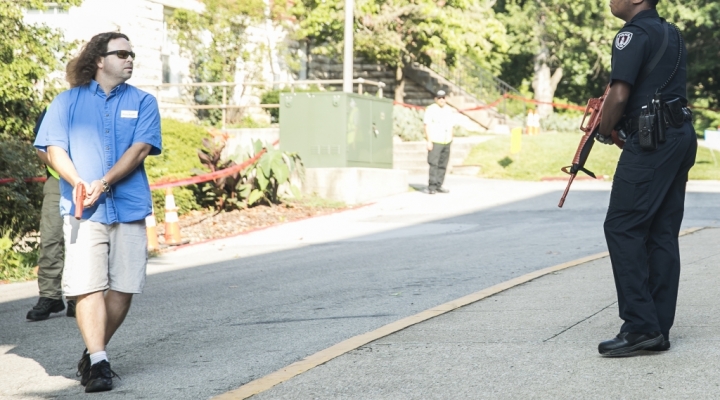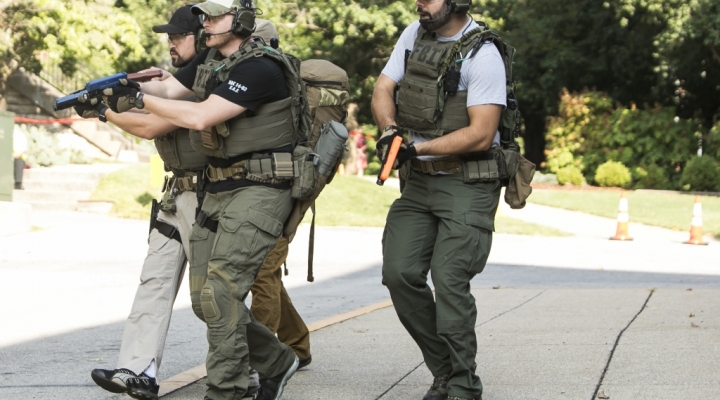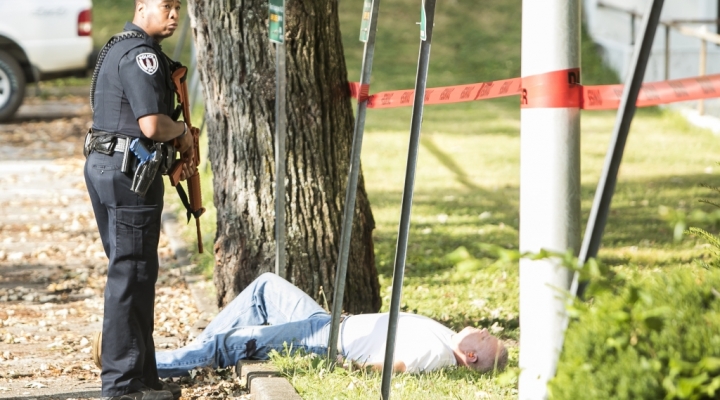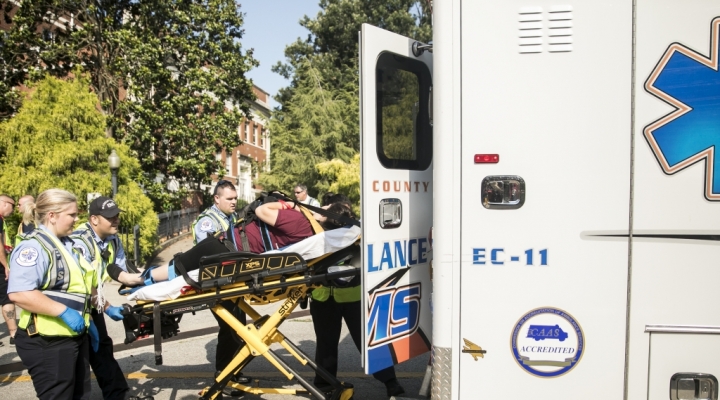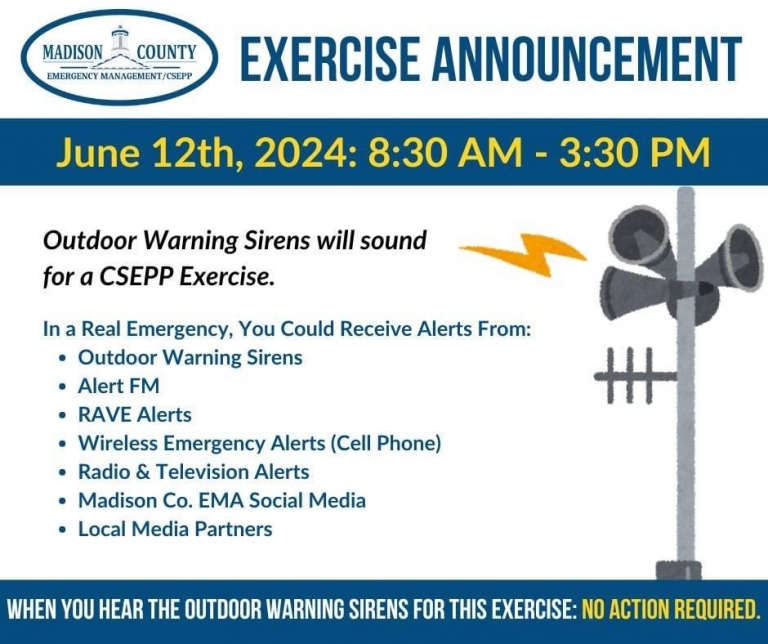Targeted Violence
WATCH OUR ACTIVE SHOOTER EXERCISE VIDEO
Your safety is very important to EKU. Maintaining your safety is a joint responsibility, between you, the University, and emergency response agencies. The person most responsible for your safety is you. Here is some important advice so you can take personal responsibility, and make informed decisions, about safe actions that you can take to protect yourself. We work to provide a safe environment for students, faculty, staff, and others to live, learn, teach, and serve in. One area of significant concern is preparing for and being able to respond to acts of targeted violence.
Targeted violence, when an individual is actively engaged in killing or attempting to kill people in a confined and/or populated area, is a highly individualized crime based upon highly individualized and unique motivators. Whether we refer to it as active violence, active shooter, or some other term, EKU Division of Public Safety personnel train frequently to appropriately respond to incidents of this kind, to stop the threat, and provide care for those impacted.
While our full time, dedicated, emergency responders have specific jobs to do during a targeted violence attack, you too have a responsibility to know what you can do to protect yourself. The information on this page is meant to help you learn about options you should consider, to prepare yourself, for a targeted violence attack, should one occur.
To help explain what you can do to protect yourself, we created the Targeted Violence Attacks Conceptual Training Frameworks listed below. When we think about targeted violence attacks, we can generally group people into one of four categories. This is important to know, because your options for consideration and action depend upon what group you belong to. There are Attackers, Targets, Responders, and Others.
The Attacker is the person perpetrating violence upon other people. They are dictating the events. A targeted violence attack is a human caused, no notice, emergency, and usually, responders do not know an attack is underway, until notifications are made via 9-1-1 calls.
Targets are the individuals who are being directly targeted by the violence. In a dangerous, or potentially dangerous, situation, you must quickly determine the most reasonable way to protect your own life. For these individuals, we recommend you Evacuate – Hide Out – Take Action (Guidance from U.S. Department of Homeland Security) or Run – Hide – Fight (Registered Trademark of the City of Houston), followed by calling 9-1-1 when it is safe for you to do so. These are essentially the same options, and are represented in the training framework with the Run - Hide - Fight graphics. To further illustrate these options for your consideration, we recommend you explore the following links and watch the following videos:
Active Shooter Poster (U.S. Department of Homeland Security)
http://emergency.eku.edu/sites/emergency.eku.edu/files/active_shooter_poster.pdf
Active Shooter Pocket Card (U.S. Department of Homeland Security)
http://emergency.eku.edu/sites/emergency.eku.edu/files/active_shooter_pocket_card.pdf
Options for Consideration Active Shooter Preparedness Video (U.S. Department of Homeland Security)
https://www.dhs.gov/options-consideration-active-shooter-preparedness-video
RUN. HIDE. FIGHT. Surviving an Active Shooter Event (City of Houston)
https://www.youtube.com/watch?v=5VcSwejU2D0
Once you call 9-1-1 to report what is happening, you start a chain of events, intended to stop the violence and warn others in the community about the danger.
Responders are the dedicated professionals who run toward the danger, to stop it, to contain it, to keep it from growing and becoming worse, and to provide life safety, environmental, and property protection at the scene of the incident. Responders include, but are not limited to, Police, Emergency Medical Services, Fire and Rescue, Emergency Management, and others. Lots of resources will be set into motion, and it is best to avoid the area, if you are not directly involved, so you don’t complicate response operations. Emergency response also includes the EKU Alert functions. More information about alerts can be found at
http://emergency.eku.edu/emergency-notifications.
Others refers to everyone else not being directly targeted by the violence. For others, we recommend that you maintain awareness about where you are, what can happen to you, how to exit every space you enter into, and where you can seek shelter wherever you go. You should also sign up for, and pay attention to, alerts that are sent to the community. You can expect that the information you get may be sparse at first. That is because it takes time for responders to assess the situation, relay information, and work the problems they encounter. We will provide updates as more information becomes available. Once informed of violence, or potential violence, we recommend that you Secure-In-Place by 1) Securing your hiding place; 2) Locking or barricading doors and windows; 3) Taking cover; 4) Silencing electronics; and 5) Waiting for updates. More information about armed intruder recommendations can be found at
http://emergency.eku.edu/sites/emergency.eku.edu/files/armed_intruder_recommendations_10102016_0.pdf.
Additionally, we want to remind everyone to watch out for each other. It can be a tough world out there, and we can all use a little help sometimes. We should strive to be inclusive, not exclusive. Be open, flexible, and unbiased. Treat everyone with dignity and respect. And if you see something or know something that you think is suspicious, say something. Contact University Police at 9-1-1 or 859-622-1111. Be sure to specify where you are; whether you are on EKU’s campuses, and your exact location. Also know that you can report tips at
http://police.eku.edu/eku-tip-reporting.
